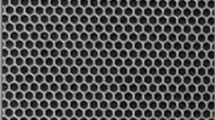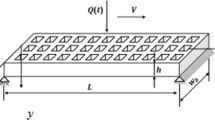Abstract
Measured damping coefficients of six different perforated micromechanical test structures are compared with damping coefficients given by published compact models. The motion of the perforated plates is almost translational, the surface shape is rectangular, and the perforation is uniform validating the assumptions made for compact models. In the structures, the perforation ratio varies from 24 to 59%. The study of the structure shows that the compressibility and inertia do not contribute to the damping at the frequencies used (130–220 kHz). The damping coefficients given by all four compact models underestimate the measured damping coefficient by approximately 20%. The reasons for this underestimation are discussed by studying the various flow components in the models.






Similar content being viewed by others
References
Bao M, Yang H, Sun Y, French PJ (2003) Modified Reynolds’ equation and analytical analysis of perforated structures. J Micromech Microeng 13:795–800. doi:10.1088/0960-1317/13/6/301
De Pasquale G, Veijola T (2008) Comparative numerical study of FEM methods solving gas damping in perforated MEMS structures. Microfluidics Nanofluidics 5:517–528. doi:10.1007/s10404-008-0264-x
Feng C, Zhao P, Liu DQ (2007) Squeeze-film effects in MEMS devices with perforated plates for small amplitude vibration. Microsyst Technol 13:623–633
Kim ES, Cho YH, Kim MU (1999) Effect of holes and edges on the squeeze film damping of perforated micromechanical structures. In: Proceedings of IEEE micro electro mechanical systems conference, pp 296–301
Kwok PY, Weinberger MS, Breuer KS (2005) Fluid effects in vibrating micromachined structures. J Microelectromech Syst 14:770–781. doi:10.1109/JMEMS.2005.845425
Mehner JE, Dötzel W, Schauwecker B, Ostergaard D (2003) Reduced order modeling of fluid structural interactions in mems based on modal projection techniques. In: Proceedings of transducers’03, Boston, pp 1840–1843
Mohite SS, Kesari H, Sonti VR, Pratap R (2005) Analytical solutions for the stiffness and damping coefficients of squeeze films in MEMS devices with perforated back plates. J Micromech Microeng 15:2083–2092. doi:10.1088/0960-1317/15/11/013
Morris CJ, Forster FK (2004) Oscillatory flow in microchannels. Exp Fluids 36:924–937. doi:10.1007/s00348-003-0776-9
Pandey AK, Pratap R (2008) A comparative study of analytical squeeze film damping models in rigid perforated MEMS structures with experimental results. Microfluidics Nanofluidics 4:205–218. doi:10.1007/s10404-007-0165-4
Sattler R, Wachutka G (2004) Compact models for squeeze-film damping in the slip flow regime. In Proceeidings of the 7th international conference on modeling and simulation of microsystems, MSM2004, Boston, pp 243–246
Schrag G, Wachutka G (2004) Accurate system-level damping model for highly perforated micromechanical devices. Sensors Actuator A Phys 111:222–228
Somà A, De Pasquale G (2007) Identification of test structures for reduced order modeling of the squeeze film damping in MEMS. In: Proceedings of DTIP symposium on design, test, integration and packaging of MEMS and MOEMS, Stresa, pp 230–239
Somà A, De Pasquale G (2008) Numerical and experimental comparison of MEMS suspended plates dynamic behaviour under Squeeze film damping effect. Analog Integr Circuits Signal Process 57:213–224
Veijola T (2006a) Analytic damping model for an MEM perforation cell. Microfluid Nanofluid 2:249–260. doi:10.1007/s10404-005-0072-5
Veijola T (2006b) Analytic damping model for a square perforation cell. In: Proceedings of the 9th international conference on modeling and simulation of microsystems, Boston, pp 554–557
Veijola T, Mattila T (2001) Compact squeezed-film damping model for perforated surface. In: Proceedings of transducers’01, Munich, pp 1506–1509
Veijola T, De Pasquale G, Somà A (2008) Comparison between damping coefficients of measured perforated structures and compact models. In: Proceedings of DTIP symposium on design, test, integration and packaging of MEMS and MOEMS, Nice, pp 236–241
Author information
Authors and Affiliations
Corresponding author
Appendix
Appendix
This Appendix contains equations for four compact models M1,…, M4. The dimensions and symbols in Fig. 1 are used: the length and width of the perforated plate are L and W. The side lengths of the square holes and the square perforation cells are s 0 and s X = s 0 + s 1, respectively. Figure 6 shows the structure of a perforation cell and the internal lumped flow resistances used in models M3,…, M6.
1.1 Model M1 equations
The equations for a narrow hole plate (L ≫ W) are given in (Bao et al. 2003). Note, in the following equations a = W/2 and b = L/2. The equivalent radii for the circular cell and hole are given in Eqs. 8 and 9. The damping coefficient c is
where
1.2 Model M2 equations
The equations for an arbitrary shaped rectangular plate are also included in (Bao et al. 2003). Also, in the following equations a = W/2 and b = L/2. The equivalent radii for the circular cell and hole are given in Eqs. 8 and 9. The damping coefficient c is
where
Above, l is the same as used in M1 equations.
1.3 Model M3 equations
A model for a circular perforation cell is derived in (Veijola 2006a), and the damping coefficient of a rectangular perforated plate is given in the paper. Note, in the following equations a = W and b = L. The equivalent radii for the circular cell and hole are given in Eqs. 8 and 9. The damping coefficient c is
Where the effective surface dimensions are
and
The flow resistance of a single perforation cell is
where the elongations are
where the functions are
The flow rate coefficients and Knudsen numbers for the air gap and the holes are
1.4 Model M4 equations
A model for a rectangular perforation cell has been given in (Veijola 2006b). Note, in the following equations a = W and b = L. The damping coefficient c is given by Eq. 11, where R P for a rectangular hole is
where the elongations are
where
The equation for ΔE includes a misprint in (Veijola 2006b). The corrected equation is shown above. The flow rate coefficients and Knudsen numbers for the square hole are
The effective radius is
Rights and permissions
About this article
Cite this article
Veijola, T., De Pasquale, G. & Somà, A. Experimental validation of compact damping models of perforated MEMS devices. Microsyst Technol 15, 1121–1128 (2009). https://doi.org/10.1007/s00542-009-0793-6
Received:
Accepted:
Published:
Issue Date:
DOI: https://doi.org/10.1007/s00542-009-0793-6




